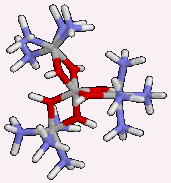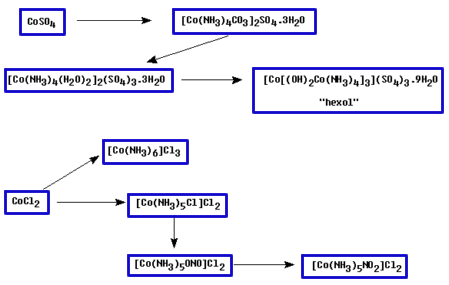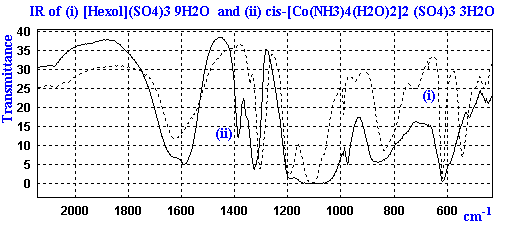
Department of Chemistry
University of the West Indies, Mona, JAMAICA
 |
HEXOL |
| By Dr. Robert J. Lancashire Department of Chemistry |
The history of modern coordination chemistry has been the subject of several books, of which perhaps the best known are those by George B. Kauffman(1,2,3). By necessity they all highlight Alfred Werner, "the Father of Coordination Chemistry", who in 1893, as a young unsalaried lecturer in organic chemistry, proposed the octahedral and square planar models for transition metal complexes.
Later that year, Werner was appointed at the University of Zurich to teach organic chemistry and subsequently 45 of his 174 publications dealt with the organic chemistry of oximes, hydroxamic acids, and dyestuffs etc. In fact, it was not until 1902-1903 that he started to teach the main lecture course in inorganic chemistry.
During the period 1893 until his death in 1919, he directed numerous dissertations (some 200 altogether, 56 of these between 1894 and 1902) and maintained a vibrant laboratory which must obviously have benefitted from collaborators from countries as diverse as Japan, Italy, UK, Sweden, the USA, and the USSR.
In 1913, he received the Nobel prize the first in Inorganic Chemistry. He was chosen "in recognition of his work on the linkage of atoms in molecules, by which he has thrown fresh light on old problems and opened new fields of research, particularly in inorganic chemistry."

Hexol Front cover pages (merged) from
book on the life of Werner.
A consequence of the octahedral model was that optical isomers should be possible for certain types of complexes. It is not clear when Werner actually realised this since it was not until 1897, that is 4 years after the original proposal, that he mentioned in a letter to Arturo Miolati that he was searching for optically active complexes. (It was with Miolati that he had published his first experimental work on coordination complexes, dealing with molecular conductance.(4))
In June 1911, when Victor King successfully resolved cis-[Co(en)2NH3Cl]2+, Werner skipped an evening lecture, a most unusual event. He was apparently worried that the sample would racemise overnight and wanted to prepare derivatives and collect as much information as quickly as possible. As it happened, the samples were quite stable.
Within eight years, Werner and his students had gone on to resolve another 40 complexes. However, because of the prevailing view that optical activity was integrally related to C atoms, Werner decided that it was necessary to prepare a completely inorganic complex (i.e., no C atoms) to prove that "carbon free inorganic compounds can also exist as mirror-image isomers".
Werner's communication dealing with the resolution and optical activity of hexol as the bromide salts (tris-{tetraammine-u-dihydroxo-cobalt(III)}cobalt(III) bromide dihydrate) was published in 1914. It had taken him 11 years from the original proposal of the octahedral model to amass sufficient experimental evidence finally to silence his opponents.
The starting material for his scheme was either Hexol sulfate, which he converted to the chloride by reacting with barium chloride, or Hexol chloride obtained from [Co(NH3)4(H2O)Cl]Cl2. He then treated this Hexol chloride salt with the resolving agent, silver d(+)-bromocamphorsulphonate, in dilute acetic acid.
The less soluble species (first precipitate) was found to be the d-Hexol salt which was then converted to the bromide. From the filtrate, the l-isomer could be isolated and converted to the bromide as well.
More recently, higher optical purity of the isomers has been achieved by using sodium bis(u-d-tartrato)-diantimonate(III) as the resolving agent. A laboratory experiment, suitable for an undergraduate inorganic course, has been published based on the revised scheme.(5)
Another laboratory exercise that gives a fairly simple sequence to the racemic mixture of hexol sulphate, was published in 1982(6). The reaction scheme in this case is given below.

The IR of these complexes give fairly broad bands due to the presence of the water, ammonia, and sulphate ions. An expanded section of the IR for the diaqua and hexol salts is shown below as a bitmap.

If you have already downloaded the JCAMP-DX viewer, then you can view the "live" spectra of the complexes, using the links below: 1)[Co(NH3)4CO3]2 SO4.3H2O
IR and Vis
Since the resolution of hexol, only a handful of other "completely inorganic complexes" have been resolved, including one, (NH4)2[PtS15] which was once described in the title of the paper as "stinking rich" (7). Hexol (resolved 1914) and (NH4)[Pt(S5)3] (resolved 1978) |
A recent study here at UWI, Jamaica(8) was concerned with determining which of two
mechanisms was involved in the rate determining step of the reduction of hexol by
L-ascorbic acid.
Did the reaction occur at the more accessible outer cobalt ions or at the central cobalt
ion?
The results suggest that it is at the central cobalt ion.
1. "Classics in Coordination Chemistry - Part 1", G.B. Kauffman, Dover
Publications Inc., N.Y., 1968.
Note: Parts 1, 2 and 3 have been collated by the IUPAC group, Committee on Teaching of
Chemistry, and were republished as the CTC Edition by Dover Publications in 1995.
2. "Alfred Werner - Founder of Coordination Chemistry", G.B. Kauffman,
Springer-Verlag, Berlin, Heidelberg, New York, 1966.
3. "Inorganic Coordination Compounds", G.B. Kauffman, Heyden & Son, Ltd.,
London, Philadelphia, Rheine, 1981.
4. see ref. 1, pages 156 and 89.
5. T. Yasui, T. Ama, and G.B. Kauffman, J. Chem. Educ., 66, 1045-1048, 1989.
6. A.M. Greenaway, and R.J. Lancashire, J. Chem. Educ., 59, 419, 1982.
7. R.D. Gillard, Chem. in Britain, 20, 1022, 1984
8. K. Abdur-Rashid, T.P. Dasgupta, and J. Burgess, J. Chem. Soc., Dalton Trans.,
1393-1398, 1996.
Home
Ja themes Lab. Manuals Lectures Search Software Spectra Staff Survey Tutorials Weekly Message UWI-Mona HomeCreated March-97. Last modified 31st August-97.
URL http://wwwchem.uwimona.edu.jm:1104/MOTM/hexol/hexol.html